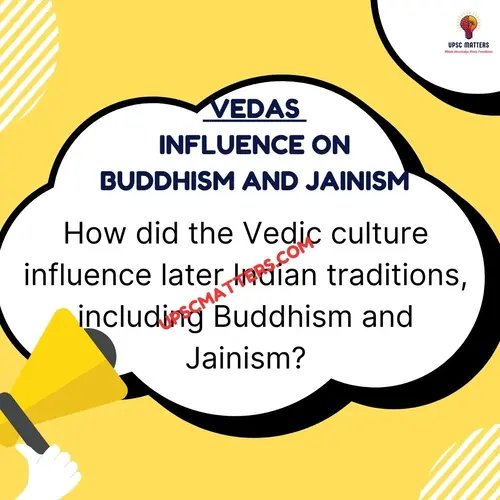The Vedic culture (c. 1500 BCE–600 BCE) laid the philosophical, religious, and social foundations of Indian civilization. Later traditions, including Buddhism and Jainism, emerged as reformist movements but were deeply influenced by Vedic beliefs, rituals, and societal structures.
Vedic Culture Influence on Buddhism and Jainism
1. Philosophical Influence
Concept of Karma and Rebirth:
- The Vedic texts, especially the Upanishads, introduced the ideas of karma (action), samsara (rebirth), and moksha (liberation).
- Buddhism and Jainism adopted these concepts but gave them a more ethical and moral interpretation.
- The Buddhist doctrine of dependent origination (Pratityasamutpada) and Jain theory of karma evolved from these Vedic ideas.
Renunciation and Asceticism: - The Vedic Aranyakas and Upanishads emphasized renunciation (Sannyasa) as a path to spiritual liberation.
- Jainism embraced severe asceticism (Mahavira’s extreme renunciation) while Buddhism promoted moderate asceticism (Middle Path).
2. Rituals and Religious Practices
Fire Worship and Rituals (Yajna):
- Vedic society centered around yajnas (sacrifices).
- Buddhism and Jainism rejected ritualistic sacrifices but retained meditative and ethical practices.
- The Bodhi tree in Buddhism and Sallekhana (fasting to death) in Jainism show continuity of sacred practices.
Mantras and Chanting Tradition: - Vedic hymns (Suktas) were recited for spiritual benefits.
- Buddhism adopted chanting of sutras, and Jainism emphasized Namokar Mantra for spiritual progress.
3. Social and Ethical Influence
Caste System and Social Structure:
- The varna system was a core feature of Vedic society.
- Buddhism and Jainism rejected caste distinctions but could not completely eliminate its influence.
- Buddhist Sangha (monastic order) was open to all, but higher castes dominated leadership.
Ahimsa (Non-Violence): - The Upanishads introduced the concept of Ahimsa (non-violence).
- Jainism made Ahimsa its central principle, extending it to all living beings.
- Buddhism promoted non-violence but allowed self-defense in extreme cases.
4. Language and Literature Influence
Sanskrit as a Base Language:
- The Vedic language (Sanskrit) influenced Buddhist and Jain scriptures.
- Early Buddhist texts (Tripitaka) were in Pali, a language derived from Sanskrit.
- Jain texts were composed in Prakrit, another derivative of Sanskrit.
Storytelling Tradition: The Puranic tradition of storytelling in Vedic culture influenced Buddhist Jataka Tales and Jain Upangas.
5. Political and Economic Influence
State Patronage of Religion:
- The Vedic concept of Rajasuya and Ashwamedha Yajna linked kingship with religion.
- Later, rulers like Ashoka (Buddhism) and Chandragupta Maurya (Jainism) patronized these traditions as part of their governance.
Trade and Monastic Centers:
The Vedic Gurukul system influenced the establishment of Buddhist viharas (monasteries) and Jain Upashrayas as centers of learning.
Conclusion
Vedic culture provided the philosophical roots, ethical principles, and social structures that influenced Buddhism and Jainism, even though they emerged as reformist traditions. While they rejected ritualism and caste rigidities, they retained core concepts like karma, rebirth, renunciation, and non-violence, shaping the evolution of Indian thought and society.
For overall understanding of the Vedic Civilization you can refer to article- https://upscmatters.com/vedic-civilization-the-foundation-of-ancient-india/
If you found this helpful, you might also like these articles:
📌 [https://upscmatters.com/indus-valley-civilization/ ]
📌 [https://upscmatters.com/what-is-history/]
They cover key concepts that will boost your preparation! 🚀
📢 Stay Updated with the Best UPSC Resources!
Join our Telegram Channel for:
✅ Daily Current Affairs
✅ Important Notes & PDFs
✅ Answer Writing Tips
✅ Strategy & Motivation
📲 Click the link to join now: [https://t.me/upscmatters] or [https://t.me/ramsirnotes]
Don’t miss out on valuable updates! 🚀


1 thought on “How did the Vedic culture influence later Indian traditions, including Buddhism and Jainism?”